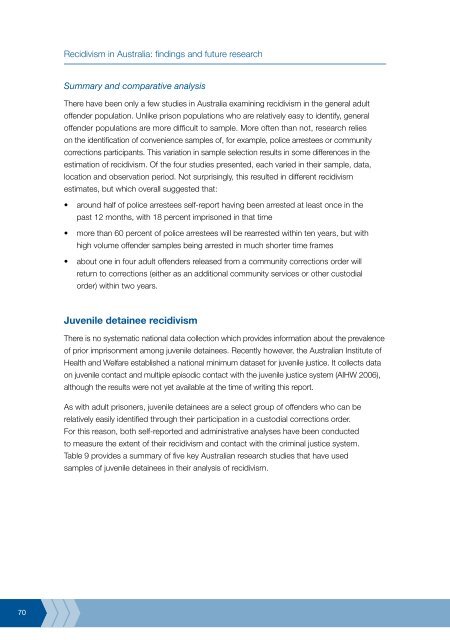Recidivism in Australia : findings and future research - Australian ...
Recidivism in Australia : findings and future research - Australian ...
Recidivism in Australia : findings and future research - Australian ...
You also want an ePaper? Increase the reach of your titles
YUMPU automatically turns print PDFs into web optimized ePapers that Google loves.
70<br />
<strong>Recidivism</strong> <strong>in</strong> <strong>Australia</strong>: f<strong>in</strong>d<strong>in</strong>gs <strong>and</strong> <strong>future</strong> <strong>research</strong><br />
Summary <strong>and</strong> comparative analysis<br />
There have been only a few studies <strong>in</strong> <strong>Australia</strong> exam<strong>in</strong><strong>in</strong>g recidivism <strong>in</strong> the general adult<br />
offender population. Unlike prison populations who are relatively easy to identify, general<br />
offender populations are more difficult to sample. More often than not, <strong>research</strong> relies<br />
on the identification of convenience samples of, for example, police arrestees or community<br />
corrections participants. This variation <strong>in</strong> sample selection results <strong>in</strong> some differences <strong>in</strong> the<br />
estimation of recidivism. Of the four studies presented, each varied <strong>in</strong> their sample, data,<br />
location <strong>and</strong> observation period. Not surpris<strong>in</strong>gly, this resulted <strong>in</strong> different recidivism<br />
estimates, but which overall suggested that:<br />
•<br />
•<br />
•<br />
around half of police arrestees self-report hav<strong>in</strong>g been arrested at least once <strong>in</strong> the<br />
past 12 months, with 18 percent imprisoned <strong>in</strong> that time<br />
more than 60 percent of police arrestees will be rearrested with<strong>in</strong> ten years, but with<br />
high volume offender samples be<strong>in</strong>g arrested <strong>in</strong> much shorter time frames<br />
about one <strong>in</strong> four adult offenders released from a community corrections order will<br />
return to corrections (either as an additional community services or other custodial<br />
order) with<strong>in</strong> two years.<br />
Juvenile deta<strong>in</strong>ee recidivism<br />
There is no systematic national data collection which provides <strong>in</strong>formation about the prevalence<br />
of prior imprisonment among juvenile deta<strong>in</strong>ees. Recently however, the <strong>Australia</strong>n Institute of<br />
Health <strong>and</strong> Welfare established a national m<strong>in</strong>imum dataset for juvenile justice. It collects data<br />
on juvenile contact <strong>and</strong> multiple episodic contact with the juvenile justice system (AIHW 2006),<br />
although the results were not yet available at the time of writ<strong>in</strong>g this report.<br />
As with adult prisoners, juvenile deta<strong>in</strong>ees are a select group of offenders who can be<br />
relatively easily identified through their participation <strong>in</strong> a custodial corrections order.<br />
For this reason, both self-reported <strong>and</strong> adm<strong>in</strong>istrative analyses have been conducted<br />
to measure the extent of their recidivism <strong>and</strong> contact with the crim<strong>in</strong>al justice system.<br />
Table 9 provides a summary of five key <strong>Australia</strong>n <strong>research</strong> studies that have used<br />
samples of juvenile deta<strong>in</strong>ees <strong>in</strong> their analysis of recidivism.















